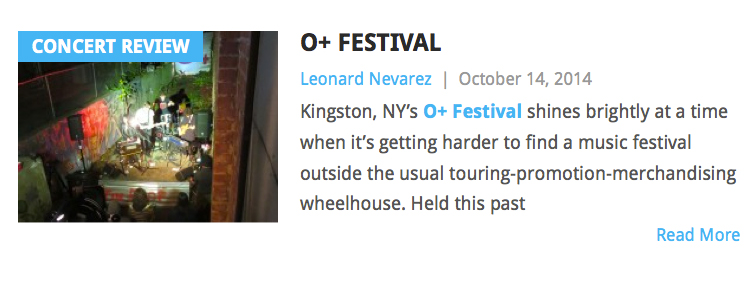Over the last month I’ve been writing for Sound It Out, a new music blog that covers adventurous new music from a snark-free, consumer-friendly point of view. “The music may be evil, but we’ll try not to be” is the motto. Most of my writings there are basic reviews and previews, but I’ve also contributed concert reviews for two Hudson Valley events that I think non-local audiences might find noteworthy: Hudson’s Basilica Soundscape (held this past September 12-14) and Kingston’s O+ Festival (October 10-12). Having attended these annual events over the last several years, I was excited for a formal opportunity to reflect on them.
When I first wrote (in 2011) about the Hudson Valley’s musical geography, the Basilica Hudson hadn’t opened, and I had yet to attend O+, which had been held only once before. If you were a fan of underground or under-the-radar rock and pop music, it seemed the Hudson Valley didn’t have much going for it. Traveling to New York for concerts, independent record stores and the like was your lot.
Three years later, the situation has changed remarkably. Hudson and Kingston have more or less usurped Woodstock’s role as the region’s touring destination, particularly for young and independent acts. As of last month the Hudson Valley has three new record stores selling, yes, new vinyl releases in addition to an impressive used inventory. And in a tangential but telling anecdote, Daryl Hall is relocating the setting for his popular web series Live From Daryl’s House from his house in eastern Dutchess County to a new club where people will be able to watch him host the guest performances. Overall, from a place where fans of adventurous, independent music might live, the Hudson Valley is becoming a destination to see, exchange, and commune around that music.
Hudson’s Basilica Soundscape and Kingston’s O+ Festival deserve much credit for this transformation, as both signature events and emblems of broader changes. My Sound It Out reviews (click on the images below to read them) allude to these events’ influence, but here are a few more thoughts on them.
It’s useful to understand the two events in terms of the audiences they seek to engage. With its lineup of cutting edge, esoteric and often extreme music, art and letters, Soundscape draws an audience versed in the aesthetics of modernism. How else might you see a 50-something modern art aficionado take in a black metal-influenced performance? The pursuit of the avant-garde in an ever-more commodified popular culture has led many to celebrate Soundscape’s location in the Basilica venue and surrounding Hudson as an opportunity to participate in “site specificity” and authentic culture more generally. An array of external trends in Hudson — particularly the in-migration of artists, writers and other exiles from gentrifying NYC, and the development of a local farm-to-table nexus — support and contextualize this celebration.
Still, Basilica doesn’t escape the contradictions of present-day Hudson, where a substantial economic underclass lives cheek-by-jowl next to the city’s genteel antiques district. When I first wrote about Basilica Soundscape, the day before its inaugural event, I wondered whether it might exacerbate this urban contradiction. Two years of glowing NY Times reviews later, I’m still waiting; no boiling point has been reached, but nor have local socioeconomic and cultural divides been significantly mended. Perhaps we won’t know until Marina Abramovic finally opens her much-ballyhooed institute for long-duration performance art.
The O+ Festival has received much less attention than Basilica Soundscape, no doubt because its lineup of performers and artists are on the whole not as widely known. It also addresses a different audience: not so much the gatekeepers of musical modernism so much as the participants and stakeholders of urban music scenes. As my review explains, O+ brings musicians and artists to perform before audiences at night in exchange for healthcare they receive in the day from mainstream and alternative practitioners. Audiences, the clubs, and local merchants get to enjoy the musical side of this barter. A wellness expo and other daytime events free to the public draws in another local constituency.
This civil society exchange is undeniably a good thing and certainly unique; I know of nothing else like O+, and it’s no wonder the event is being exported to Petaluma next month and (the latest news) Chicago next year. I’m excited by the possibility that analysts and boosters of urban music scenes might take more seriously the broader foundations of ‘a scene’ and the possibilities for non-commodified creativity modelled by O+. Of course, community means several things, and if O+ neglects any one in particular, it might be the municipal populace of Kingston. In a city where about 1 in 6 residents is African American, about the same number are Latino, and a comparable proportion lives under poverty — these proportions increase around the uptown district where the festival is held — the O+ playlist is, culturally speaking, fairly white, fairly bohemian-bourgeois. A wellness expo open to the public is laudable, but I look forward to an O+ lineup that highlights a more culturally inclusive notion of community.
My photos from Basilica Soundscape: day 1 and day 2.
My photos from O+ Festival: day 1 and day 2.
For other Hudson Valley writings on musicalurbanism.org, click here.


